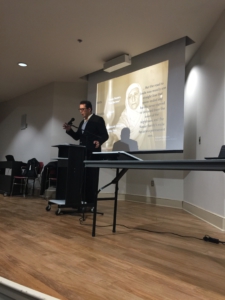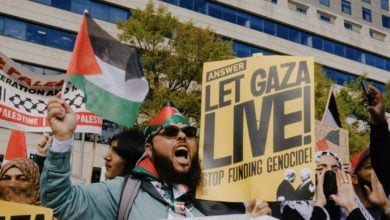
“I started with a question. What if the Palestinian people were allowed to tell their own story? If history is told from the people’s point of view, are they going to convey the reality of their story the same way it is conveyed by the spokespeople and the aristocracy and the political elite and so on and so on?” Ramzy Baroud opened with this powerful and simple thought on Feb. 3 in Atlanta at Columbia Theological Seminary Lecture Hall. Baroud was the guest of Joining Hands for Justice in Palestine and Israel, a local non-profit which sponsors frequent pro-Palestinian events in the Atlanta area. His lecture centered around the narratives in his most recent book, “The Last Earth: A Palestinian Story” where he did extensive research for several years both in Palestine and the diaspora, collecting stories to write an original history of Palestine that centers the voices and stories of the people who usually go unheard, the actual Palestinian people themselves.
Baroud’s mentor and PhD advisor was well known historian Ilan Pappe. In the introduction to his lecture, Baroud mentioned that Pappe was the first Israeli Jewish historian to call the Nakba by its correct name — ethnic cleansing. He then pointed out that often in the discourse around Palestine we are quick to note “the first Israeli historian to name this or name that,” but that Palestinians have been naming massacres and ethnic cleansing as massacres and ethnic cleansing since they day that they happened. It is only the mainstream discourse which needs non-Palestinians to say these things in order for them to have legitimacy.
This was the central idea that led Ramzy to write his most recent book. He wanted to tell the story and the history of Palestine through the authentic narratives of the Palestinian people themselves. He conducted hundreds of interviews over many years, not just within Palestine, but the diaspora as well, gathering and collecting these stories to weave a new original narrative. He tried especially to adapt not just the narratives but also the timelines that the story tellers wanted to prioritize, instead of following the traditional academic framework.
“The first idea we need to get rid of is seeing Palestinian history as simply starting in 1947/48, then going to 1967, then going to the first Intifada, and so on. We have to stop defining people’s history as merely a progression from tragedy to tragedy. Bring the Palestinian to the podium. Don’t marginalize him. Don’t hide him. Palestinians have to be able to claim their own positionality in the story and everything that comes along with that position.” said Baroud. “It should be the people that determine the priorities. Their narratives are consistent with the present but aware of the past.”
Baroud made reference to the classic Edward Said essay, “Permission to Narrate,” in which Said argues that for Palestinians, the storyteller is never allowed to be part of the story. Speaking about the political fallout after “a handful of poorly armed Palestinians and Lebanese held off a very large Israeli army, air force, and navy from June 5 till the middle of August [1982].” (Edward Said, Permission to Narrate, Journal of Palestine Studies,Vol. 13, No. 3 (Spring, 1984), pp. 29)
Said pointed out that something shifted as it related to the idea of Palestinian liberation and the Palestinian people themselves. “That something was, I think, the inadmissible existence of the Palestinian people whose history, actuality, and aspirations, as possessed of a coherent narrative direction pointed towards self-determination, were the object of this violence … I recall during the siege of Beirut obsessively telling friends and family there, over the phone, that they ought to record, write down their experiences; it seemed crucial as a starting-point to furnish the world some narrative evidence, over and above atomized and reified TV clips of what it was like to be at the receiving end of Israeli ‘anti-terrorism,’ also known as ‘Peace for Galilee.’ Naturally, they were all far too busy surviving to take seriously the unclear theoretical imperatives being urged on them intermittently by a distant son, brother, or friend. As a result, most of the easily available written material produced since the fall of Beirut has in fact not been Palestinian and, just as significant, it has been of a fairly narrow range of types.” (Edward Said, Permission to Narrate, Journal of Palestine Studies, Vol. 13, No. 3 (Spring, 1984), pp. 29, 38)
Said summed up the complexity of the problem faced by Palestinians in telling their stories. The resistance in Lebanon in the summer of 1982 was a major moment in gaining more global recognition for Palestine and the struggle for liberation there. However, the violence and destruction of their communities as a result of the Zionist occupation, not just in 1982 but since its inception, is such an incredibly dislocating force for the entire diaspora that often survival has to take primacy over storytelling. This is precisely the gap that Ramzy Baroud seeks to address with his latest work.
This reporter asked JHJPI director Sarah Humphrey why she thought it was important to bring Baroud to speak and what it was about his message that resonated most. She responded that: “Ramzy Baroud’s latest book “The Last Earth” is an important, compelling ‘people’s history’ of the Al-Nakba al Mustamera — the ongoing catastrophe. The settler colonial project is understood at a much deeper level through the stories of these lived/remembered experiences. Baroud’s presentations in Atlanta challenged us to hear these stories and to continue our struggle against the powers of imperialism.”
One of the most powerful stories in the book is that of Ahmad al-Haaj, who as a boy was given the nickname Abu Sandal by his classmates as he was the only one of them who could afford footwear. Ahmad was a lifelong communist who helped his family escape several times from Zionist militias, keeping them safe until they eventually were made permanent refugees in Gaza. During the fighting of the summer of 1948, Ahmad was in the middle of evacuating from his family’s hometown of Al-Sawafir and found himself in the village of Beit Daras, when yet again the Zionist militias violated the ceasefire agreement and ethnically cleansed yet another Palestinian village.
“Within the first hour of fighting, Beit Daras was on fire. Those who could not fight attempted to quell the flames of treason, but to no avail. Those who managed to escape ran to the Egyptian army, stationed only three miles north … It was too late anyway. By then the militias had moved in, and executed survivors of the initial onslaught, civilians and all, whoever they were — men, women, children — it made no difference. There were neither rules of war nor rules of engagement. Some escaped running through burning fields, tripping on one another while chased by sniper bullets. The few who remained alive arrive in Joura, Al-Majdal, Hamameh and the other nearby villages. The demise of Beit Daras had crushed the spirit of the smaller and less defendable villages. The massacre instilled fear and horror, especially as the death toll reached three hundred in a village with a population that barely totaled two thousand.
The mukhtars of the much smaller Al-Sawafir met again and resolved that Be’er Toviya was likely to continue its attacks now that the heart of resistance had gone up in flames. They urged the people to sleep in open fields for fear that their homes would be burned in the middle of the night while they were inside. Terrified and unsure of the plan that guaranteed nothing, hundreds of families walked late at night to nowhere in particular, hauling whatever food they could manage, and pushing along their cattle and donkeys. They all slept under the open sky, with the intention of returning in the morning to salvage whatever else they could carry — their chickens, the remaining flour, bottles of olive oil, small stacks of corn, and lentils.” (Ramzy Baroud (2018), The Last Earth: A Palestinian Story. London: Pluto Press, pp. 61-2)
During the discussion session at the end of the lecture, Baroud was asked what he thought was the most important thing people could do to organize around the cause of Palestinian liberation. He replied, “I have two things for you. Number one, let’s not play by their rules anymore. To not engage with bad faith accusations of antisemitism at every turn. These kinds of conversations are not aimed at trying to find solutions, they are aimed at trying to create distractions.” Baroud referenced the ongoing spurious allegations of antisemitism that Labour Party leader Jeremy Corbyn has had to endure simply for standing up for the rights of Palestinian people as an example of the kind of derailing conversation that the pro-Israel forces engage in.
“And number two, join BDS. The reason that BDS scares them is because it is a unifying movement, it brings people together.” Baroud mentioned that BDS creates many angles for solidarity both in terms of the actual boycott, but also in terms of the intellectual resources shared when people support the movement. Because the movement also has a component of educating people about the issues in Palestine and telling the authentic stories of the Palestinian people directly, it has the effect as Baroud said, of “putting Palestine on the agenda. It is necessary to walk away from the elitist discussions. We must move to the streets. We must move to the Palestinians and hear their stories.”
By prioritizing the narratives and timelines of the people, Baroud has created a fundamentally materialist record of Palestine and its people. Centering the stories of the most marginalized communities — in this case those directly affected by Israeli apartheid — is exactly what is needed to continue building the broad working-class movement that will liberate both Palestine and the world! From the river to the sea, Palestine will be free!





